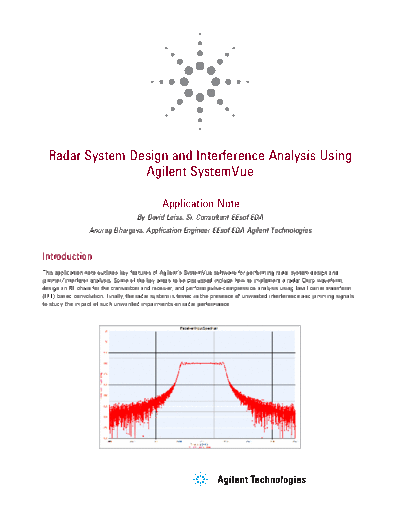Service Manuals, User Guides, Schematic Diagrams or docs for : HP Publikacje 5990-5393EN
<< Back | HomeMost service manuals and schematics are PDF files, so You will need Adobre Acrobat Reader to view : Acrobat Download Some of the files are DjVu format. Readers and resources available here : DjVu Resources
For the compressed files, most common are zip and rar. Please, extract files with Your favorite compression software ( WinZip, WinRAR ... ) before viewing. If a document has multiple parts, You should download all, before extracting.
Good luck. Repair on Your own risk. Make sure You know what You are doing.
Image preview - the first page of the document

>> Download 5990-5393EN documenatation <<
Text preview - extract from the document
Radar System Design and Interference Analysis Using
Agilent SystemVue
Application Note
By David Leiss, Sr. Consultant EEsof EDA
Anurag Bhargava, Application Engineer EEsof EDA Agilent Technologies
Introduction
This application note outlines key features of Agilent's SystemVue software for performing radar system design and
jammer/interferer analysis. Some of the key areas to be discussed include how to implement a radar Chirp waveform,
design an RF chain for the transmitter and receiver, and perform pulse-compression analysis using fast Fourier transform
(FFT) based convolution. Finally, the radar system is tested in the presence of unwanted interference and jamming signals
to study the impact of such unwanted impairments on radar performance.
1.0 Custom Signal Generation
1.1 LFM Chirp for Radar System Design
SystemVue offers a flexible platform to create custom
signals. In the example shown in Figure 1-1, SystemVue
floating-point Data Flow components were used to model
the LFM Chirp source. The integrator on the left incre-
ments time until the value for the pulse period is achieved,
causing it to reset and start over. The values for u () and
wc (c) are computed as shown in Figure 1-1.
(1-1a)
(1-1b)
Figure 1-1. Custom signal generation using SystemVue DSP library blocks
2
1.0 Custom Signal Generation, Continued
1.2 Custom Signal Generation using MathLang
SystemVue offers built-in m-code compatible syntax to be
used throughout the program. In Figure 1-2, the LFM Chirp
source is defined in a MathLang component.
1.3 Custom Signal Generation using Third-Party Tools
SystemVue offers direct links with C++, HDL and
MATLAB◦ Jabse Service Manual Search 2024 ◦ Jabse Pravopis ◦ onTap.bg ◦ Other service manual resources online : Fixya ◦ eServiceinfo